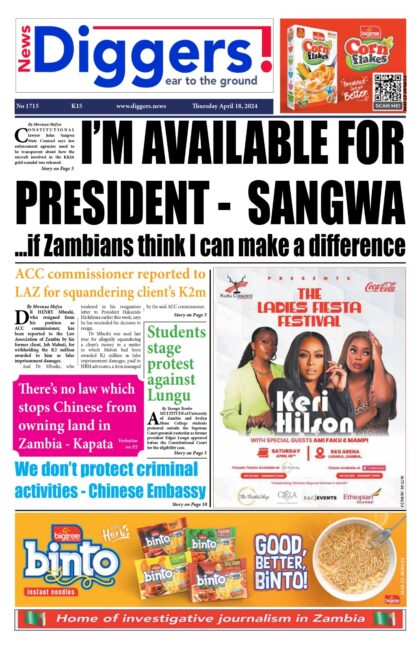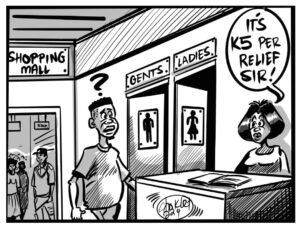Zesco Limited says despite floods in many parts of the country, the Kariba Dam water levels are still low as the main catchment area in the southern part of the country has received below normal rainfall.
Speaking during a media tour of the Kariba North Bank Power Station, Friday, Zesco managing doirector Victor Mundende, in a presentation made on his behalf by company Director Generation Fidelis Mubiana, said the power utility would maintain load shedding of between 10 to 12 hours a day for the rest of the year.
“So just to compare, last year, we were given 17 billion cubic meters of water and this year we have been given 11 billion cubic meters, so you can see that this year we have less and just to say that from an installed capacity of 1,080MW, we are only given 275MW to generate. So you can see our units, our machines are all available, we actually run and reach this capacity but we can’t because the water is not enough so we only have 275MW. We have a total generation now sitting at 1072MW and a peak demand of 2,200MW hence our shortfall is 810MW at peak so we have to find ways and means of living with this, for now at least, even as we put in measures to mitigate this deficit. As a result of this Zesco is saying that we are maintaining load shedding of 10 to 12 hours but even then, I think most of our customers will agree that when we do have some gains in the system, we are able actually to supply power at a lesser load shedding bandwidth but for us to maintain our system, this is what is recommended,” Mundende said.
He said unfortunately, COVID-19 had stalled some critical projects.
“We are supposed to commission this plant [at Kafue Gorge Lower], at least the first unit should have started running I think by mid of the second quarter but I must say that we have had the impact of COVID felt of this power plant. So because of COVID, there has been some challenges that have led to a few delays in the project. The materials where they are coming from abroad, you know our supply chains have been disrupted so we are having problems in getting our material on time. The staff I think in January this year, we had our staff from contractor Sinohydro who had gone back to China for a short break and were caught up in the COVID, they could not come back on time and as a result, we have had a few delays. So now we are looking at commissioning the first unit at the end of the second quarter or beginning of quarter three. Because the disruptions from COVID are still ongoing and Zesco are still assessing to see how we can balance everything,” Mundende said.
“Zesco has implemented a first level lockdown at the Kafue Gorge Lower site so that people that are working are secluded and no one can go in nor go out to avoid entry of COVID on site but what this means is that we can have other people that we require to come and maybe ramp up activities and we don’t know who is coming with COVID so they have to stay away and we will make do with the staff that we have.”
He said water levels at the dam stood at 22.16 per cent compared to about 35 per cent recorded during the same period last year.
“The 2019/20 Hydrological season begun on 1 October 2019. The 2019/2020 rainfall season performed above average for most parts of the country except a few areas in the southern part. Inflows into the Lake Kariba reservoir remained poor up until mid-March 2020 when it exceeded the comparable Long Term Mean, the 2014/15 and 2018/19 hydrological years. The period Mid-March to date, the lake received reasonably high inflows with a peak of 4149 m3/s on 31 March 2020 with the expected second peak yet to occur. 2019 End of Year Reservoir level was 476.69m above sea level which is 8% of the Live Storage. Projected 2020 end of year reservoir level will be advised by Zambezi River Authority (ZRA),” he said.
“Yes, the rainfall has been very good in the nation, it has been above normal, but if you scan back and look at these areas here [southern part], these are actually below normal and this is where we have the lower catchment area for Kariba and also Itezhi-tezhi. Yes, we have had floods in Copperbelt, Eastern and Luapula provinces but not much of floods in the southern part. Yes we had a bit of flooding in Gweembe that was only for a few days, and then it went down. In fact, we would wish that those floods which were happening would happen here then we would have been very happy in terms of water.”
He insisted that it was impossible to fill the dam in one rainy season, as it would take three seasons of good rainfall to fill the Kariba.
“Kariba dam is a multi-year reservoir, what I mean is that you cannot fill the dam in one single season, it takes three years of good rainfall to fill it up to the maximum, similarly, it means on the reverse side, when it is full, you can use the water from that reservoir for the next three years even when you have a drought as long as you are not using it at full generation but at minimum generation. So where we are right now, we are beginning from a very low level, about seven per cent and we are trying to raise the reservoir so that we can have enough storage so it means that this year we can’t, no matter how good the rainfall is, we can’t fill the reservoir but we can only raise up to a third of what we can raise to reach the maximum,” Mundende said.
Meanwhile, the managing director revealed that the company is currently importing 200MW from SAPP to help cushion the deficit in the country.
“Zesco is currently trading on the SAPP day ahead market where we trade and get some power, we get 200MW to just cushion here and there. So when power is available and it’s at a good price, we are able to get that power and that is why you will see that maybe load shedding has gone down a bit because we have been able to get some power at a good price. So this helps us to supplement power from other sources,” said Mundende.












